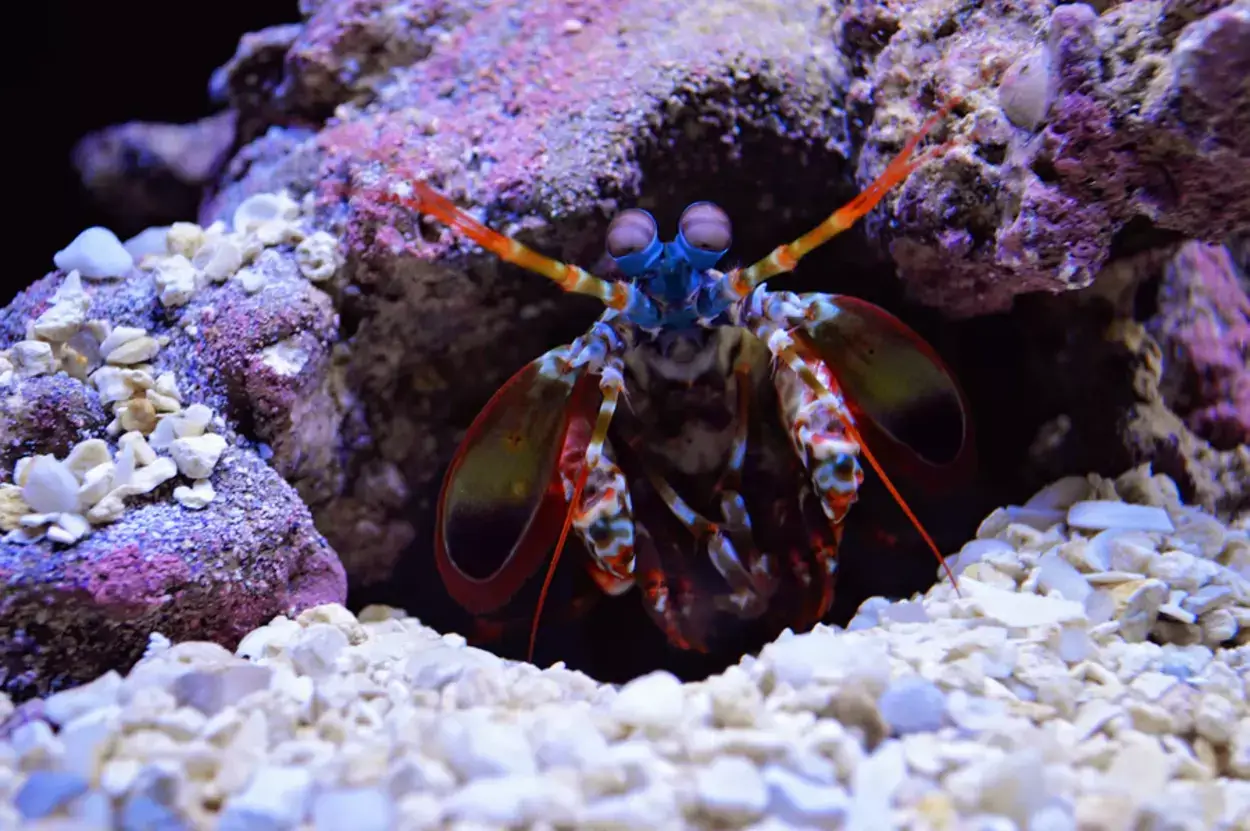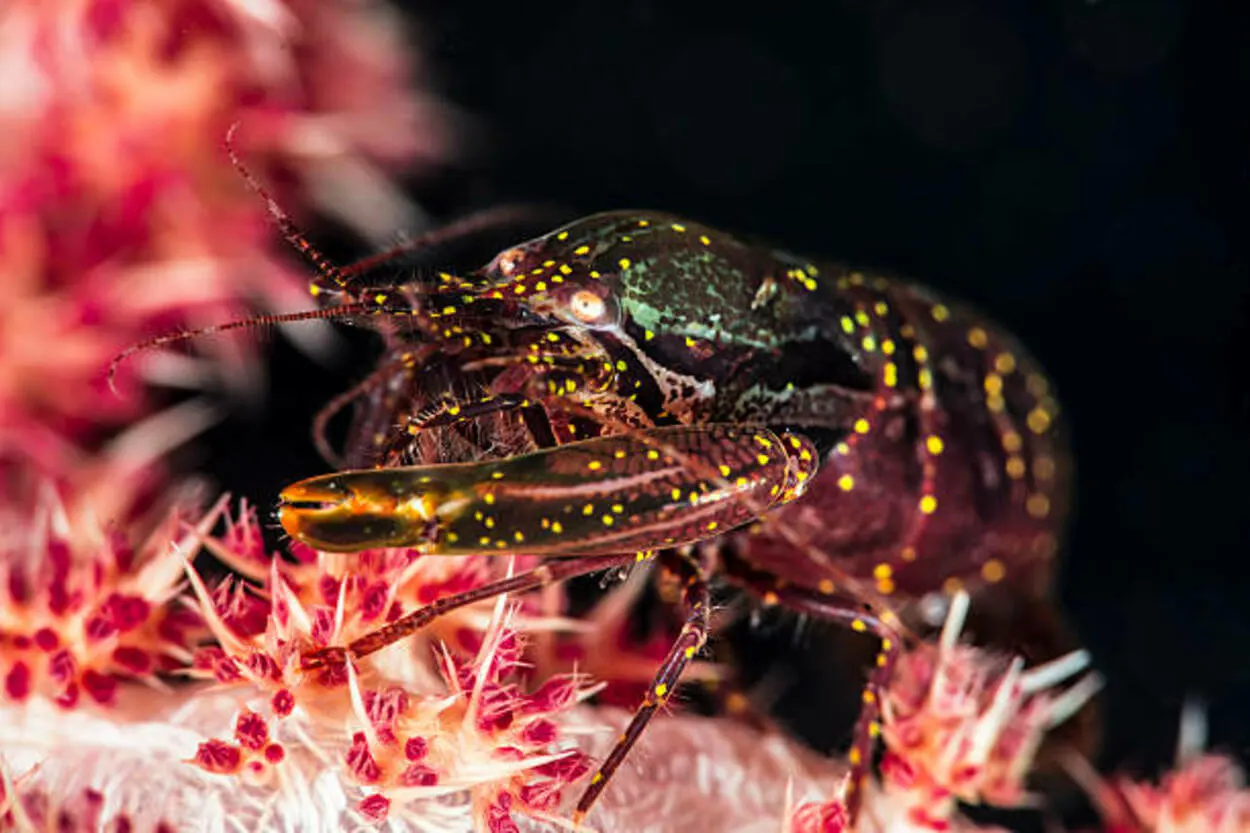Over 300 distinct varieties of shrimp can be found in the ocean. While most people associate shrimp with commercially accessible varieties, there are a few species that are less well-known, such as the pistol and mantis shrimp.
Both of these aquatic species are noted for their incredible self-defense abilities. If they are ever assaulted or attacked by their prey, they will put up a good fight.
In this article, you’ll learn more about the differences between these two shrimp, including how they protect themselves from predators.

What Is a Mantis Shrimp?
Mantis shrimps are highly aggressive crustaceans with enormous, raptorial claws similar to those of a praying mantis.
Many are vibrantly colored in red, green, brown, and blue hues. Mantis shrimps were known as ‘sea locusts‘ by the ancient Assyrians. Mantis shrimps are also now known as ‘shako,’ ‘prawn killers,’ and ‘thumb splitters,’ among other names.
‘Spearers’ and smashers are the two main varieties of mantis shrimp. Both varieties of raptors attack by rapidly unfolding and swinging their raptorial claws at their target. ‘Spearers‘ have a claw coated with multiple sharp teeth, which they use to impale victims.
Mantis shrimp are found in over 400 different species around the world. In the Indo-West Pacific region, there are almost 250 species, with more than half of them found in Australia.
New species are discovered on a regular basis, even off the coast of New South Wales. In many regions of the world, mantis shrimps support significant fisheries, yet they are vulnerable to exploitation and habitat degradation.
The majority of mantis shrimp species live alone, although some species live in pairs for the whole of their lives. Mantis shrimps can be found in coral reef burrows and crevices, as well as on the seabed at depths of up to 1500 meters.
Mantis shrimps perform a critical function in marine ecosystems, regulating the numbers of other species and encouraging greater total species diversity.
The digging behavior of mantis shrimps also adds to the turnover and oxygenation of sediments where the seafloor is soft. Mantis shrimps are also sensitive to toxins in the environment and serve as good bioindicators of coral reef contamination.
They can eat soft-bodied creatures like:
- worms
- shrimp
- fish
They can eat hard-bodied creatures as well such as:
- snails
- crabs

What Is a Pistol Shrimp?
Pistol shrimp are one of a kind among shrimp species. They are equipped with a single enormous claw that may be employed as a sonic weapon, emitting a burst of sound that is capable of killing small marine species.
Even though pistol shrimp are little, they make a surprising lot of noise in the ocean, and their snapping has been known to cause submarine navigation equipment to malfunction.
Alpheidae, the wide family that includes hundreds of species of pistol shrimp, is the formal name for pistol shrimp. In regard to the family, some biologists use the moniker Alpheid shrimp.
Pistol shrimp, like other shrimp, are crustaceans with a variety of legs and claws for navigation and prey manipulation.
The claws of a pistol shrimp are unique in that they’re symmetrical, with one arm being significantly larger than the other. Surprisingly, if a pistol shrimp’s snapping arm is disabled or severed, the other claw will expand in size to compensate.
Because the Alpheid family is so broad, snapping shrimp species can be found all over the planet. The organisms reside in burrows and can be found in coral reefs, submarine grass mats, and oyster flats, among other places.
Other organisms, such as sponges or goby fishes, may create symbiotic partnerships with pistol shrimp in some situations. Some even live in freshwater, exhibiting the enormous biological diversity seen in just one family.
Cracking Sound of Pistol Shrimps
Initially, biologists assumed that the cracking sound of pistol shrimp was created by the snapping arm’s claws clicking together. The sound, however, is created by a cavitation bubble.
When a pistol shrimp snaps its claw, it fires a high-velocity water jet into the air, causing turbulence and the production of low-pressure bubbles. When the ocean’s enormous pressure pops the bubbles, they make a crisp “crack” like a pistol.
When the bubbles burst, they appear to produce a momentary flash of light. The air inside the bubbles cannot escape because the bubbles compress so quickly. As a result, it becomes superheated, nearing the temperature of the sun’s surface at times. The flash of light is known as “sonoluminesence,” and it appears to be unique to pistol shrimp, according to biologists who have not seen anything similar in other creatures.
Despite the fact that pistol shrimp pose little harm to humans, they pack a powerful punch for such small creatures.
What Is the Difference Between a Mantis Shrimp and a Pistol Shrimp?
Between a Mantis shrimp and a Pistol shrimp, there are numerous differences. The variances are due to differences in appearance, size, vision, nutrition, predators, and even defense tactics.
Mantis shrimp are typically 8–10 in (20–25 cm) long and come in a variety of bright red, blue, or green colors. It’s one of the few animals that can perceive circularly polarised light. This can be done horizontally, vertically, or diagonally.
Mantis shrimp can also rotate their eyes in both clockwise and counterclockwise orientations. They’ll be able to see their prey more clearly as a result of this.
They would construct a hole for protection and love sub-Antarctic water. While most of them are nocturnal, a few will go out during the day in search of food.
Because mantis shrimp are much larger than pistol shrimp, they’ll require a greater amount of prey to survive, such as:
- Crabs
- Fish
- Worms
Mantis shrimp are threatened by humans, bluefin tuna, and barracudas.
Whereas, a pistol shrimp is red with white dots or stripes and is 1-2 inches (2.5-5 cm). When clapped together, its asymmetrical claws make a loud snapping sound. Because they can snap and kill their prey, they are also known as ‘snapping shrimp.’
When it pinches prey with these claws, it transmits a stun gun-like sensation through their body, paralyzing them, hence the name. The eyes of pistol shrimp feature photoreceptors that allow them to see a few colors, but their vision is weak.
These shrimp prefer to stay hidden within coral reefs and can be found in both tropical and temperate climates. They require a warm environment in which to appreciate the warm water.
Moreover, the snapping shrimp eats other little shrimp such as mysis and brine. They even make an attempt to collect little crabs, but they are rarely successful. Some of the most common predators of pistol shrimp include triggerfish, lionfish, hawkfish, and wrasses.
Here’s a table to make it easier for you to understand the differences between a mantis shrimp and pistol shrimp:
| Characteristics | Mantis Shrimp | Pistol Shrimp |
| Appearances | 8-10 inches long | 1-2 inches long |
| Origin | Prefer to live in sub-Antarctic water and will create burrows to live in | Commonly found in tropical and temperate climates and enjoys living in coral reefs |
| Scientific Name | Alpheidae | Stomatopoda |
| Diet | They feed on larger animals, such as crabs, fish, and worms | They feed on small shrimp, like mysis and brine |
Which Is More Stronger: Mantis or Pistol Shrimp?
A mantis shrimp is significantly more powerful than a pistol shrimp. Both shrimp species are quite predatory, but the mantis shrimp has a stronger build than the pistol shrimp and hence has an edge.
Despite its diminutive size, the pistol shrimp defends itself only with its enormous claw. When it sets its claw on its target, it sends a blast of heat, light, and sound through bubbles into the prey’s body, instantaneously killing it. If this claw is broken or eaten in any manner, it will regrow immediately.
The pistol shrimp is most likely spouting its dangerous bubbles if you hear strange popping sounds while snorkeling or swimming underwater. The pistol shrimp’s claw snaps so swiftly that it alters the surrounding water pressure, causing a loud pop.

Conclusion
- Mantis Shrimp are 8 to 10 inches long, while Pistol Shrimp are 1-2 inches long
- Mantis shrimp like to live in sub-Antarctica. Whereas, Pistol shrimp are commonly found in tropical climates.
- The other name used for Pistol Shrimp is snapping shrimp.
- Mantis shrimp have different colors including bright red, green, and yellow to dull brown.
- Pistol shrimp often have red and white bodies.
Other Articles
- Birria vs. Barbacoa (What’s the Difference?)
- Different Types Of Steaks (T-Bone, Ribeye, Tomahawk, and Filet Mignon)
- What’s The Difference Between The Sweet Potato Pie And The Pumpkin Pie? (Facts)

